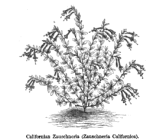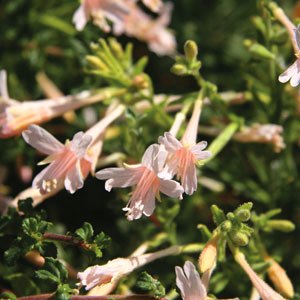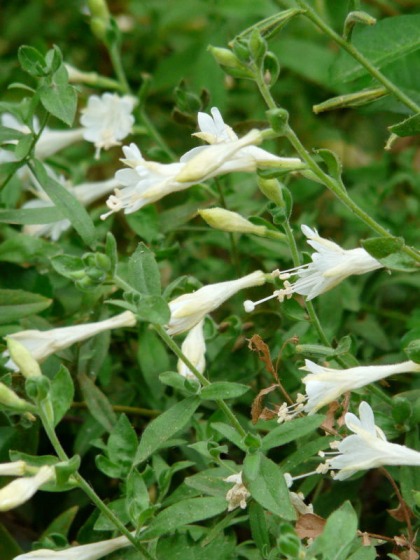California Fuchsia, easy to grow, complicated in name
Growing California Fuchsia is like hanging out a neon sign to a certain pollinator, namely hummingbirds! It also fills a need many native plant gardeners have of maintaining a colorful garden all year and Zauschneria fits that description. The red, red-orange, pink, or white blossoms — sized just for a hummingbird’s beak — open in late summer and fall, when most natives are dormant and very few are flowering.


Now, many know that the name was changed some time ago to Epilobium for various reasons, but I’ll stick with Zauschneria, which I can say, barely. I have affection for plants named after people and Johann Baptista Josef Zauschner, a professor of medicine and botany in Prague in the second half of the eighteenth century, sounds like a fascinating fellow. All my efforts to find out why a Czech doctor would have a California plant named for him were frustrated. As far as I can tell, he was an amateur botanist who wrote a paper on a particular Star of Bethlehem and whose papers were lost during WWII. Had the History of Botany in Bohemia been translated to English, there might have been a chance to solve the mystery.
More spelling
“Fuchsia” is named after the sixteenth century botanist Leonhard Fuchs. Note the spelling of Fuchsia – the “s” falls after the “ch” and not before, a very common misspelling that has been called to my attention! California fuchsias are in the same plant family as the common hanging-basket fuchsias and are native to the tropical zones.
Varieties commonly available
Zauschneria ‘Bowman’s #1’ Bowman’s #1
San Marcos Growers say: There are two Bowman cultivars with #1 being an upright plant, particularly attractive to hummingbirds and Bowman #2 being a prostrate plant. They were both selected by legendary plantsman Ed Carman in the San Jose garden of Bob Bowman’s parents. Bob Bowman who actively hybridized other California Fuchsia at UC Davis speculated that these selections were hybrids between a Zauschneria septentrionalis from along the Trinity River and a Zauschneria canum from south of Big Sur. This plant was one of the highest rated California Fuchsia in Rancho Santa Ana Botanic Garden’s ‘Horticultural Trials for California Epilobium’.”
Zauschneria californica California Fuschia
Zauschneria canum latifolium California Fuschia is said to be the most hardy.
Zauschneria ‘Catalina’ Catalina California Fuschia
Las Pilitas Nursery says: “This California fuchsia is a fairly large upright flowering perennial. Very showy in late summer and fall when covered with 1-2 inch fuchsia flowers. But the primary reason to plant it is for the hummingbirds that park in mass in the garden when this California fuchsia is in flower.”
Zauschneria ‘Etterii’ Silver Threadleaf Hummingbird Trumpet
High Country Gardens raves about this one, “Oh my, what is that exquisite plant?” exclaimed a recent visitor to our gardens! That plant is the incredible ‘Etteri’ form of our native Zauschneria with its explosion of deep, scarlet-red trumpets held over a haze of narrow-leaved silver foliage. Best planted in an infertile, well-drained loam soil with lots of sun. Don’t cut back until spring. Occasional deep watering over the winter is needed if conditions are dry. Zones 5-9.”
Zauschneria ‘Everetts Choice’, low and compact
Zauschneria septentrionale ‘Select Mattole’
Suncrest Nurseries say: “Plants of this species make silvery mounds or mats, otherwise similar to E. canum. ‘Select Mattole’ was collected in the wild by Ray Collett and Brett Hall. This is a more broadly matting form, just as silvery and producing an abundance of scarlet flowers.”
Zauschneria ‘Sierra Salmon’ Salmon California Fuchsia
El Nativo Growers say: “The numerous Zauschneria selections and hybrids that are readily available provide a diverse palette of colors and textures from which to choose. Foliage colors come in greens and grays, and most are covered with soft hairs. Traditional flower colors are an orangey-red, but can also be found in pink and white.”
Zauschneria ‘Solidarity Pink’ Pink California Fuchsia
Siskiyou Rare Plant Nursery says: “This choice selection bears an abundance of large, shell-pink flowers in loose racemes from summer through autumn, on a slowly spreading plant. Hardy to Zone 7”
Growing California Fuchsias
Drought tolerant but shade loving, late in the season flowering from August to September, California Fuchsia seems to be an ideal plant for a California garden, however there is a dreaded anecdote from Judith Lowry Larner that it could be appetizing to deer. It, combined with Autumn sages, California aster and Copper Canyon daisy would be my idea of a colorful late summer.
California Fuchsias are perennials in the evening primrose family; some will spread by underground rhizomes, and some will occasionally re-seed in the area. They also are said to perform beautifully in pots and baskets. For a slope, this is a great choice when planted with other natives that prefer full sun, little water and excellent drainage.
In my garden, Everett’s Choice, a low and compact form, has been languishing (eaten?) on my clay bank, when ‘Catalina’, a tall and rampant one should have been selected for that spot. However I still have a desire for California Fuchsia, so I will undoubtedly try for more.
I will follow Tree of Life Native Nursery’s advice: “Epilobium canum (formerly Zauschneria californicum) – Species occurs statewide, has gray-green foliage. 1’ tall and 4’ wide. Spreads through re-seeding. Suggestion: group it with buckwheat (Eriogonum), monkey flower (Mimulus), Penstemon, and coast sunflower (Encelia) on a bank to create a dream garden for pollinators and nearly year-round color.”
I have a spot in mind…
Notes:
Paper-Generally accepted plant names based on material from the Czech Republic and published in 1753–1820
“Johann B. J. Zauschner (1737–1799)
Most of our knowledge of J. B. J. Zauschner comes from the work of Von V. Maiwald (1904) who studied the archives of Charles University, Prague (the archives were stolen by German troops at the very end of the World War II and totally disappeared; there are only fragments left in the current University archives). Zauschner was mainly a physician and also specialized in mineralogy. His main botanical paper was published in 1776 and contains Kirschner et al.: Plant names from the Czech Republic 325 a description of Ornithogalum bohemicum ( Gagea bohemica, a Star of Bethlehem). Maiwald (1904: 66) mentioned a herbarium collection of Zauschner: “Seine Pflanzensammlung erhielt das Stift Strahow”. (Its plant collection received the Strahow writings) However, the collection has not been traced in the Strahov Monastery.”
Recent Posts
How to Be a Lazy Gardener
...and still have a pretty garden With a busy household and jobs, we are…
Summer is Spring at Whiskey Falls!
Take a day trip to Whiskey Falls... Come visit Whiskey Falls and the surrounding high…
California oak acorns: Feast or famine
Why do oaks drop more acorns some years and not others? If you have live…
Mule’s ear and Farewell to Spring
Roadside treasures worth stopping for In the first week of July in the Sierra foothills…
Our favorite butterfly plants
Wow! Butterflies love these plants! Grow any of these for instant results and each is…
A water-saving veggie garden for the foothills
Your water-wise veggie garden Does everyone in our Mountain Community grow at least one tomato?…


